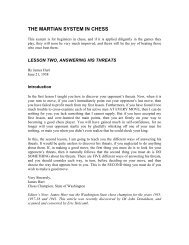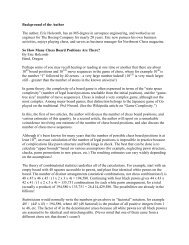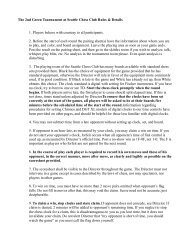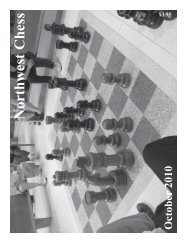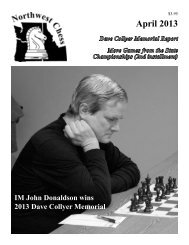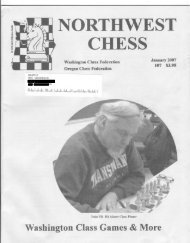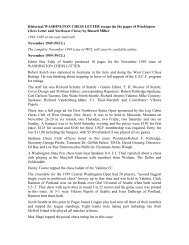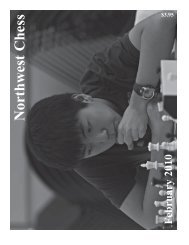Create successful ePaper yourself
Turn your PDF publications into a flip-book with our unique Google optimized e-Paper software.
This month we look at the theory of<br />
R+BP+RP vs. R. I will make use of the<br />
normal convention and assume that it is<br />
White that has the extra material. Unless the<br />
black king is cut-off from the kingside,<br />
White’s primary winning chance is using<br />
one of his pawns as a decoy. Having said<br />
that, using the h-pawn as a decoy is logical<br />
since there are more R+P vs. R winning<br />
position with an f-pawn as opposed to an h-<br />
pawn. However, even after the black king<br />
takes the h-pawn decoy, it stands well on<br />
the short side, and with correct defense a<br />
drawn position should be reached. Before<br />
tackling R+BP+RP vs. R, let’s look at<br />
several R+BP vs. R positions with the black<br />
king correctly placed on the short side.<br />
Position #1<br />
This position is a dead draw; there is<br />
nothing White can do to improve his<br />
position. For example 1. Rd1 Ra7+ etc.<br />
While simple, this is important to know<br />
since it is the normal end result when White<br />
uses his rook to shield the king from side<br />
checks on the d-file instead of the e-file.<br />
Position #2<br />
And In The End<br />
by Dana Muller<br />
This is a standard draw. The play is quite<br />
simple: if the white rook isn’t on the f-file,<br />
then keep your defending rook behind the<br />
pawn on the f-file. If White moves his rook<br />
to the f-file, then move your rook to the a-<br />
file for side checks.<br />
1. Ke6 Kg7<br />
The king holds back the pawn.<br />
2. Re7+ Kf8 3. Rf7+ Kg8 4. Ra7 Kf8<br />
5. Kf6 Kg8 6. Ra8+ Kh7<br />
And we are back where we started.<br />
1. Rf8 Ra1 2. Kg5<br />
Other king moves allow a barrage of<br />
checks on the long-side; rook moves are<br />
answered by Rf2.<br />
2. ...Rg1+<br />
And the check barrage is from the back<br />
instead of the long side.<br />
Position #3<br />
This is another typical king on the short<br />
side position, it is critical in the sense that<br />
whoever has the move gets their desired<br />
result. This sort of position with White to<br />
play is White’s main goal in the more<br />
complex R+BP+RP vs. R ending. Needless<br />
to say, Black doesn’t have to allow it.<br />
White to play:<br />
1. Kf8 Kg6 2. f7 Rb7 3. Re6+ Kh7 4.<br />
Rf6 Ra7 5. Ke8 Ra8+ 6. Ke7 Ra7+ 7. Ke6<br />
Ra6+ 8. Ke5<br />
And wins, as now further checks are<br />
answered by marching the king toward the<br />
rook.<br />
Black to play draws:<br />
1. ...Rb7+ 2. Re7<br />
If 2. Kf8 then 2. ...Kg6.<br />
2. ...Rb8<br />
The key move – stopping the white king<br />
from reaching f8. Other moves lose, i.e. 2.<br />
...Rb6 3. Kf8+ Kg6 4. f7 Rb8+ 5. Re8 Rb7<br />
6. Re6+ Kh7 7. Rf6.<br />
3. Ke6+<br />
The alternatives 3. Re8 Rb7+ repeating,<br />
or 3. Rd7 Ra8 or 3. Ra7 Kh6 don’t improve.<br />
3. ...Kg6 4. Rg7+ Kh6 5. Rg1<br />
Cutting off the king and trying to reach<br />
the Lucena position, but...<br />
5. ...Rb6+<br />
And the black keeps checking, if the<br />
white king approaches the black rook, then<br />
the black rook attacks the f-pawn<br />
Now that we are experts at R+BP vs. R,<br />
lets move on to some R+BP+RP vs. R<br />
positions. The generic advice on playing<br />
black is to keep the king on g7 as long as<br />
possible and answer any pawn checks by<br />
moving in front of that pawn.<br />
The rook is often best placed on a1 ready<br />
to give checks from behind or along the a-<br />
file as needed. Sometimes posting the rook<br />
on the f-file behind the white f-pawn can be<br />
effective. There is one other consideration<br />
not always mentioned: if the white pawns<br />
are not advanced very far and the black king<br />
is cut-off from the h-pawn by the white rook<br />
on the g-file, then use a frontal attack (e.g.<br />
Rh8) on the h-pawn. This may sound<br />
obscure, but it will make sense after<br />
reviewing the game Keres – Sokolsky.<br />
The first three examples are what Black<br />
must avoid (or what White is trying to<br />
achieve). The next two examples show<br />
Black successfully defending.<br />
Page 24 <strong>Northwest</strong> <strong>Chess</strong> August 2009



